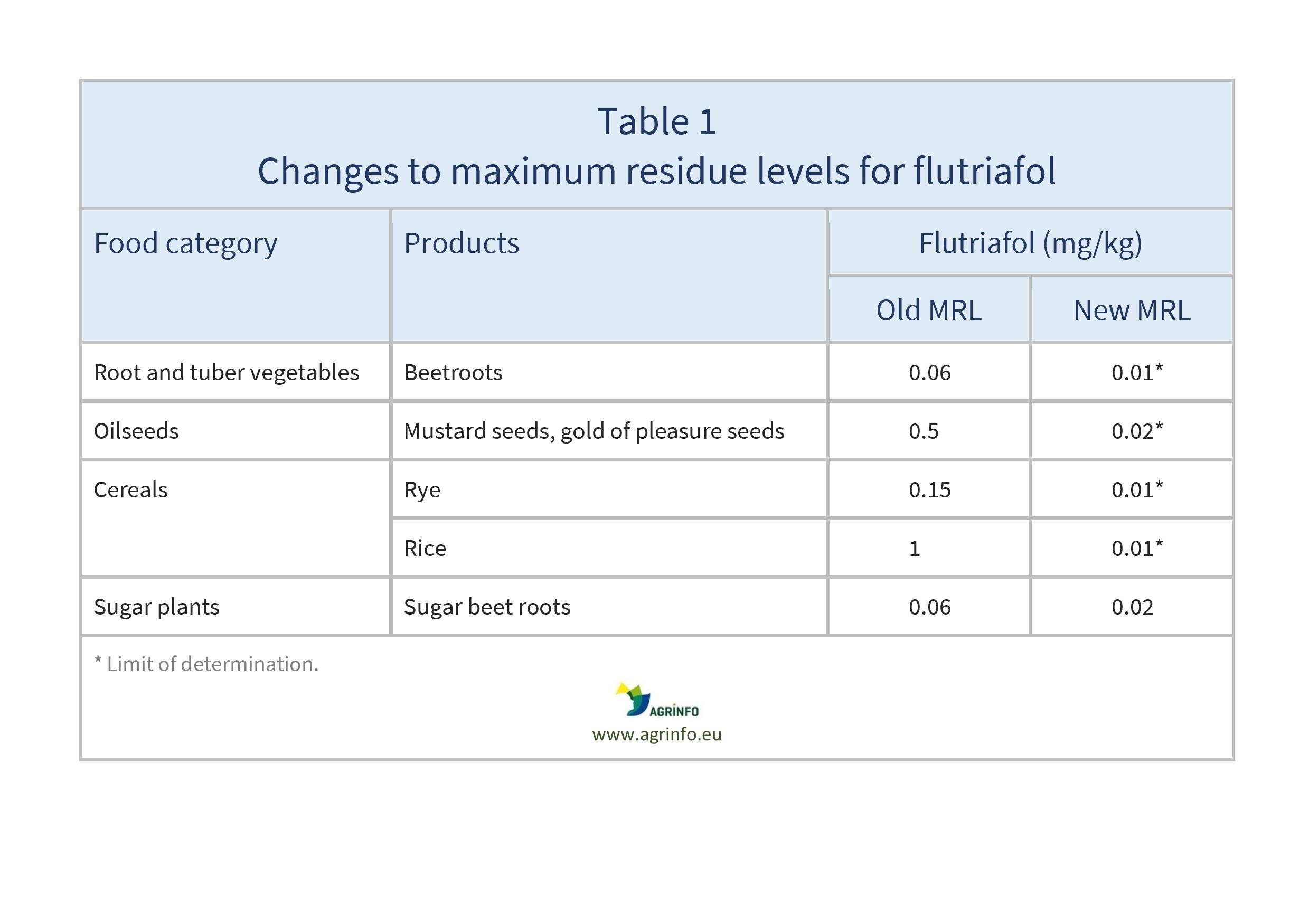MRLs for flutriafol
- Food safety
- Pesticide MRLs
- Pesticides
Summary
The EU has set the maximum residue levels (MRLs) for flutriafol to the limit of determination (LOD, the lowest level that can be detected using the most modern and reliable analytical methods). This will apply to all products except those for which MRLs are based on Codex MRLs (CXLs) or import tolerances, which are considered safe. There will be potential impacts on exporters of beetroots, mustard/ gold of pleasure seeds, rice, rye, and sugar beet roots.
EU lowers MRLs for flutriafol on beetroots, mustard/gold of pleasure seeds, rice, rye, and sugar beet roots
Commission Regulation (EU) 2024/341 of 22 January 2024 amending Annexes II and V to Regulation (EC) No 396/2005 of the European Parliament and of the Council as regards maximum residue levels for diethofencarb, fenoxycarb, flutriafol and pencycuron in or on certain products
Update
The EU has set the maximum residue levels (MRLs) for flutriafol to the limit of determination (LOD, the lowest level that can be detected using the most modern and reliable analytical methods). This will apply to all products except those for which MRLs are based on Codex MRLs (CXLs) or import tolerances, which are considered safe. There will be potential impacts on exporters of beetroots, mustard/ gold of pleasure seeds, rice, rye, and sugar beet roots.
Impacted Products
beetroots, mustard seeds, gold of pleasure seeds, rye, rice, sugar beet roots
What is changing?
The EU has amended the MRLs for flutriafol as summarised in Table 1.
Why?
The approval for flutriafol has not been renewed as the manufacturer did not support its application for approval. Therefore flutriafol is no longer authorised in the EU and all MRLs are set at the LOD.
However, EFSA has concluded that some products present no health risks for the consumer (EFSA 2014, 2016a, 2016b, 2016c, 2017, 2020). In these cases import tolerances or CXLs are maintained.
Timeline
The new MRLs will apply from 12 August 2024. Products exported before 12 August 2024 that comply with the old MRLs will not be removed from the EU market after 12 August, even if they do not comply with the new MRLs.
Recommended Actions
Exporters of beetroots, mustard/ gold of pleasure seeds, rice, rye, and sugar beet roots should review their current use of flutriafol and evaluate possible alternative solutions.
Background
MRLs are set in accordance with the rules set out in Regulation EC (No) 396/2005. For information on current MRLs for other substances, please consult the EU Pesticide Residues database.
Resources
EFSA (2014) Reasoned opinion on the review of the existing maximum residue levels (MRLs) for flutriafol according to Article 12 of Regulation (EC) No 396/2005. EFSA Journal, 12(5): 3687.
EFSA (2016a) Scientific support for preparing an EU position in the 48th Session of the Codex Committee on Pesticide Residues (CCPR). EFSA Journal, 14(8): 4571.
EFSA (2016b) Setting of import tolerance for flutriafol in strawberries. EFSA Journal, 14(3): 4427.
EFSA (2016c) Setting of import tolerance for flutriafol in cucurbits with edible peel. EFSA Journal, 14(9): 4577.
EFSA (2017) Setting of import tolerance for flutriafol in hops. EFSA Journal, 15(7): 4875.
EFSA (2020) Evaluation of confirmatory data following the Article 12 MRL review and setting of an import tolerance for flutriafol in cucurbits (inedible peel). EFSA Journal, 18(12): 6315.
Sources
Commission Regulation (EU) 2024/341 as regards maximum residue levels for diethofencarb, fenoxycarb, flutriafol and pencycuron in or on certain products
Tables & Figures

Source: based on Regulation 2024/341
Disclaimer: Under no circumstances shall COLEAD be liable for any loss, damage, liability or expense incurred or suffered that is claimed to have resulted from the use of information available on this website or any link to external sites. The use of the website is at the user’s sole risk and responsibility. This information platform was created and maintained with the financial support of the European Union. Its contents do not, however, reflect the views of the European Union.
EU lowers MRLs for flutriafol on beetroots, mustard/gold of pleasure seeds, rice, rye, and sugar beet roots
Commission Regulation (EU) 2024/341 as regards maximum residue levels for diethofencarb, fenoxycarb, flutriafol and pencycuron in or on certain products
What is changing and why?
The approval for flutriafol has not been renewed as the manufacturer did not support its application for approval. Therefore flutriafol is no longer authorised in the EU and all MRLs are set at the LOD. However, EFSA has concluded that some products present no health risks for the consumer (EFSA 2014, 2016a, 2016b, 2016c, 2017, 2020). In these cases import tolerances or CXLs are maintained.
Changes to the maximum residue levels (MRLs) for flutriafol are set out in Table 1.
Actions
Exporters of beetroots, mustard/ gold of pleasure seeds, rice, rye, and sugar beet roots should review their current use of flutriafol and explore alternative solutions.
Timeline
The new MRLs will apply from 12 August 2024. Products exported to the EU before 12 August 2024 that comply with the old MRLs will not be removed from the EU market after 12 August, even if they do not comply with the new MRLs.
Tables & Figures

Source: based on Regulation 2024/341
Disclaimer: Under no circumstances shall COLEAD be liable for any loss, damage, liability or expense incurred or suffered that is claimed to have resulted from the use of information available on this website or any link to external sites. The use of the website is at the user’s sole risk and responsibility. This information platform was created and maintained with the financial support of the European Union. Its contents do not, however, reflect the views of the European Union.
